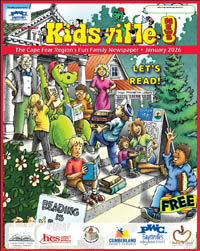Sticklers for Grammar
- Details
In early 2001, Up and Coming Weekly publisher Bill Bowman asked me to write this column. Bless his sweet little heart. It has been and continues to be among my life’s great challenges and pleasures, and I treasure the interaction it has provided with people from all parts of our community.
English majors are not generally noted for our math skills, but if my calculations are correct, I think I am approaching 300 Up and Coming Weekly columns, even allowing for a few vacations and the one week I simply forgot to write any column at all following the General Election of 2002. Each column seems like a child to me, but some clearly generate more reader interest than others.
Readers had a great many thoughts on a number of columns over the years regarding my take on a little girl in foster care for nearly six years, teenaged mothers and tattoos. The column which elicited the most comment, though, and which people still talk to me about did not seem so provocative at the time I wrote it early this year. In fact, I thought I might hear from a teacher or two, or perhaps from no one at all.
I learned quickly that there are a lot of English language lovers and grammarians out there. Sticklers even.
Being one myself, I was greatly pleased by the response from folks who are tired of hearing and reading the butchering of our language and frustrated by a lack of concern from too many people, educators included.
Well, sticklers, I have some good news for us. Teaching grammar, it seems, is coming back into fashion.
The same day I heard a CNN reporter whose editor was clearly on a lunch break tell viewers that another person had been traveling with “my camera crew and I,” one of Fayetteville’s premier sticklers, Jane Buryk, sent me an article by Daniel de Vise in the Washington Post. De Vise chronicles the resurgence of grammar education in some high-performing high schools in the Washington area, and reports that students who study it are scoring better on high-stakes state tests and on the always-dreaded SAT.
When I was in school way back in the dark ages of the 1960s, we did study grammar, and we executed long and complicated diagrams of sentence structure with nouns and verbs on horizontal lines and the words which modified or described them written on diagonal lines below. Even I will confess that the work could be a bit tedious, and by the freewheeling 1970s, grammar education was on the decline. De Vise reports that in 1985, the National Council of Teachers of English blessed this turn in education thinking by declaring grammar drills “a deterrent to the improvement of students’ speaking and writing.” Apparently, students were supposed to learn grammar and sentence structure simply by speaking and writing in English.
So what has changed over the last 20 years or so?{mosimage}
Students did not learn proper English by osmosis and continued to “lay” down instead of “lie” down and to give the dog “it’s” food instead of “its” food. They continued to ask, “where is the book at?” De Vise reports on one high school teacher who does teach grammar and who tested the comma skills of some up and coming Advanced Placement students. “…they’ll get it right about half the time,” notes the teacher. “But half is an F.”
We might have gone on like this indefinitely with no one concerned but the sticklers except for a change on the world stage, the emerging global economy.
Suddenly, the world was opening up and Americans found ourselves competing not just against each other for a leg up in the worldwide marketplace. Suddenly, we Americans and those coming along behind us are competing with people literally on the other side of the Earth, some of whom can speak and write our own language better than we can. It became obvious that we would have to hone our skills in all sorts of ways.
And, then came the icing on the grammar education cake — the new writing portion of the SAT introduced last year which presents both a long-form essay composition and multiple choice questions addressing sentence structure. De Vise notes that the high school class of 2006, the first to take the new writing portion of the SAT, posted the lowest verbal scores in a decade.
Human beings use many unspoken clues to assess other people. We take in their clothes, the vehicles they drive, their voices, and their public conduct to form opinions about them. Poor manners and poor hygiene clearly send negative messages, and I think poor English language skills communicate precisely the same unappealing impression.
If I were an employer interviewing for a position of responsibility and upward potential and have several intelligent and qualified candidates, I will gravitate toward the one who has manners and who speaks and writes correctly. I suspect you would as well.

 How to resolve AdBlock issue?
How to resolve AdBlock issue? 








